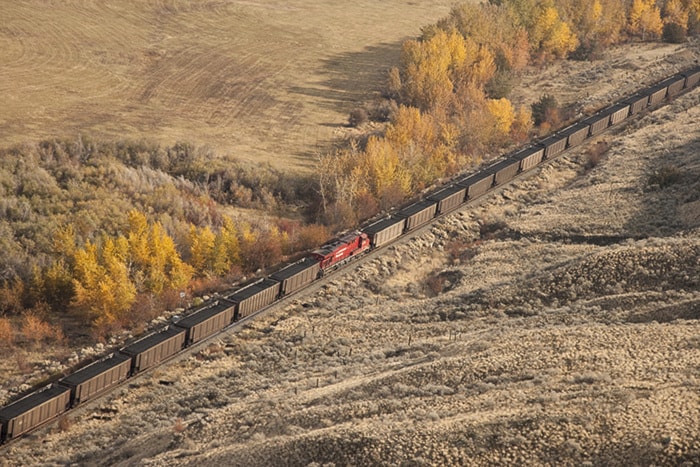CP Rail carries dangerous goods across North America – and Salmon Arm is no exception.
"Must CP Rail move dangerous goods through Salmon Arm, as well as 1,100 other communities? Yes, we're required," said Mike LoVecchio of CP Rail during a presentation to Monday's meeting of the city's development and planning services committee.
"Let's be candid," he said, noting substances such as ammonia, chlorine, crude oil and jet fuel are among those that the railway carries daily in Canada. He explained that CP operates under "common carrier obligation," an obligation under Canadian law which says all commodities are equal.
Dangerous goods are currently about five per cent of overall traffic, he said.
CP owns the rails, while the tank cars are owned by different companies.
"They're owned by the product producers or third-party lessors," he said, adding that the product is owned by its producers.
Following the tragic derailment in Lac-Mégantic, Quebec last July, which occurred on a line owned by U.S.-based MMA Railway, LoVecchio said CP has been stepping up its conversation with communities far and wide, providing them with an overview of emergency process and planning to help educate the public, councils and first responders.
"It's important for you to know, we are one of the safest ways to move dangerous goods," he said, explaining that the process for shipping such goods is lengthy and starts before CP sees the tank car. Then, prior to departure, the cars are visually inspected and, while in motion, the company uses track-side technology to monitor the cars.
A hot box detector at the side of the track measures the temperature of the wheels, he said, technology which helps fix problems before they manifest.
"The detector sends a message to the crew, axel number 224, or whatever it is, has triggered an alarm."
Then the train is brought to a measured stop and the wheel is inspected and repaired, if necessary, at the next set-off location, one of which is in Salmon Arm west of Marine Park Drive.
"We have turned ourselves from being reactive to proactive."
He said the train involved in Lac-Mégantic was operated by a single crew person, while CP operates all its trains with two crew members.
MMA and CP’s tracks connect just east of Montreal, he said.
The DOT-111 tank cars are the most common in the North American fleet and were used in the Lac-Mégantic derailment, he noted.
CP believes it’s time for the old tank cars to be upgraded, LoVecchio said, but the company doesn’t own them.
“We have levied a tariff on each tank car. A surcharge of $325. It’s an incentive to get owners to get on with replacing them.”
LoVecchio recounted that Mayor Nancy Cooper had informed him a coal train tipped a couple of years ago in Canoe. The first priority of CP Rail is for its crew and residents in the proximity, he said. Next is the environment. Also important is keeping the line open.
“All will likely happen at the same time…”
LoVecchio said communities have a role to play with regard to zoning, not allowing development close to tracks.
“A railroad is an industrial site. It operates 24-7, it transports dangerous goods.”
In the past, he said, companies that produced the products were required to test and classify them. Now, until there's greater confidence in testing, the government will classify risk.
"In my view it's a pragmatic change, one we support."
Coun. Ken Jamieson said he is interested in the inventory of dangerous goods going through. He asked about the possibility of receiving advance notice.
He was told the information is available in a quarterly report, after the fact, but not before shipments take place.
Several first responders and members of Salmon Arm’s emergency operations team were present.
While LoVecchio said CP prefers ‘table top’ training scenarios over mock exercises, Cliff Dougherty, the Columbia Shuswap Regional District's emergency program coordinator, said local emergency operations personnel like to do mock exercises every three years because they reveal issues sometimes unconsidered.
For instance, he said, last exercise there were 99 ‘patients’ and it was discovered that when the hospital got to 59 people it couldn’t handle any more.
Salmon Arm Fire Chief Brad Shirley asked for details about CP Rail’s emergency procedures and will pursue setting up a training session with CP.
Coun. Chad Eliason asked if there’s anything the city can do to prevent possible spills into the lake.
LoVecchio said CP Rail is asking the city to replace the Marine Park crossing with an underpass, citing two pedestrian deaths there in recent years.
He said the company would have funds to contribute, but didn’t say how much.
Eliason asked again about spills, and LoVecchio said the company has environmental response professionals.
“We are appropriately resourced for that.”
Coun. Alan Harrison asked about the most common causes of derailment. LoVecchio said there are lots of moving parts on a train, so lots of causes. However, he said, a lot of mechanical failure has been eradicated.
“The stuff we can’t control is what keeps us up at night,” said LoVecchio. He pointed to the recent incident in Malakwa where a pick-up truck left the highway, crossed through oncoming traffic and ended up getting hit by a freight train.
“You’ve gotta wonder about a universe where this kind of thing could even happen.”
LoVecchio said CP Rail owns 16,000 miles of track in six Canadian provinces and 13 American states.
